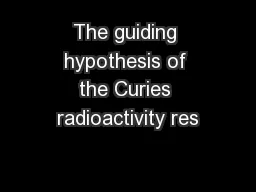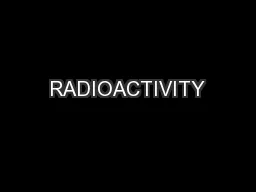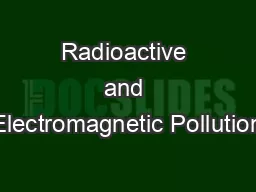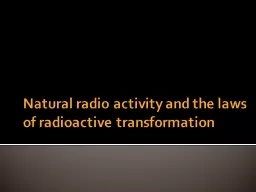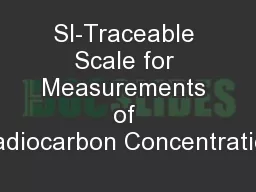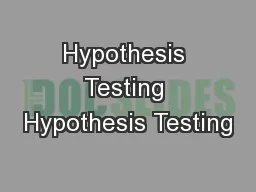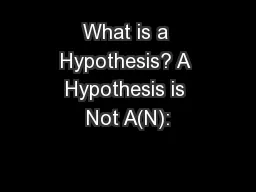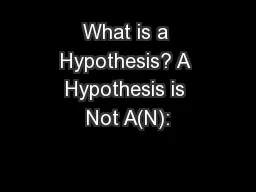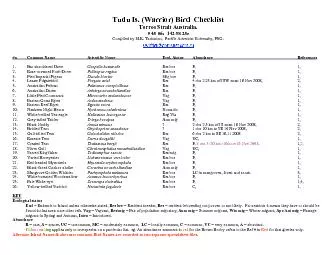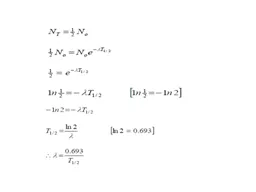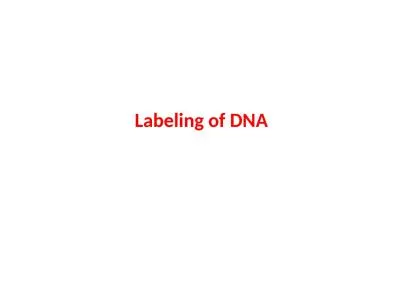PDF-The guiding hypothesis of the Curies radioactivity res
Author : phoebe-click | Published Date : 2015-05-24
unicampbr Group of History and Theory of Science State University of Campinas Unicamp Brazil Pierre and Marie Sklodowska Curies main discoveries on radioactivity
Presentation Embed Code
Download Presentation
Download Presentation The PPT/PDF document "The guiding hypothesis of the Curies rad..." is the property of its rightful owner. Permission is granted to download and print the materials on this website for personal, non-commercial use only, and to display it on your personal computer provided you do not modify the materials and that you retain all copyright notices contained in the materials. By downloading content from our website, you accept the terms of this agreement.
The guiding hypothesis of the Curies radioactivity res: Transcript
unicampbr Group of History and Theory of Science State University of Campinas Unicamp Brazil Pierre and Marie Sklodowska Curies main discoveries on radioactivity are usually regarded as empirical investigations that were developed without any theoret. For . B.Sc. Chemistry (General), Part- I. By. Dr. . Kakoli. . Banerjee. Department of Chemistry. Aims and Objectives. Definition of Radioactivity . Discovery of Radioactivity- The Pioneers. Cause of Radioactivity- Nuclear Instability. Pierre Curie was already a famous scientist before he married Marie Sklodowska in 1895. This famous couple did not only find true love, they also discovered radium and polonium. For their groundbreaking research in radioactivity, the couple were awarded the 1903 Nobel Prize in physics. It was Marie Curie who coined the term "radioactivity", and in her honor, the 1910 Radiology Congress chose the curie as the basic unit of radioactivity. Pierre died from being run over by a horse drawn wagon, but Marie continued their research, and was eventually awarded a second Nobel Prize, the 1911 prize for Chemistry. She died in 1934, suffering from pernicious anemia which had undoubtedly been the result of years of radiation exposure.. Their Effect on Health, The Energy Field. and The Immune System. Dr. Donna M. Starita, DVM, Medical Intuitive. … And Effective Ways To Protect Yourself. Electromagnetism: The Phenomenon Associated With Electricity and Magnetism And Their Interactions With Each Other. Section 4. Page 17. 1. Essential . Issues to Consider. The two sets of guiding principles provided here are considered . best practice for all actors . in humanitarian and emergency settings. It is important that . Nuclear Stability . Nuclear stability . means that nucleus is stable meaning . that it . does not spontaneously emit any kind of radioactivity (radiation). . On the other hand, . if the . nucleus is unstable (not stable), it has the tendency of emitting some kind of . Joseph T. Hodges. , Adam J. Fleisher, Qingnan Liu, Abneesh Srivastava and David A. Long. Chemical Sciences Division. National Institute of Standards and Technology . Gaithersburg, MD. joseph.hodges@nist.gov. Test of hypothesis - Test whether a population parameter is less than, equal to, or greater than a specified value.. Remember an inference without a measure of reliability is little more than a guess.. – What is it?. All substance are made of . atoms. . These have . electrons. (e) around the outside, and a . nucleus. in the middle. The nucleus consists of . protons. (p) and . neutrons. (n), and is extremely small. (Atoms are almost entirely made of empty space. Q. uestion. R. andom guess. Observation. Experiment. Your mom. A . hypothesis is:. A . tentative explanation . for an observation or a scientific problem that can be tested by further investigation. . Q. uestion. R. andom guess. Observation. Experiment. Your mom. A . hypothesis is:. A . tentative explanation . for an observation or a scientific problem that can be tested by further investigation. . Nomadic P, 1, 11. White-bellied Sea-eagle Haliaeetu Anous minutus ? 2 obs 2.5 km off S coast 16 Nov 2008, 2, 14. Bridled Tern Onychoprion anaethetus ? 1 obs 10 km to SE 16 Nov 2 The number of atoms, . N. , remaining at a particular instant in time is given by: . A = . λ . N . Where . A . = the activity, The traditional unit for activity is called the curie (. Ci. ).. . 1 curie = 3.7 x 1010 disintegrations per second (. Rate of Radioactive decay with units. Geiger-Muller Counter. An atom is composed of positively charged nucleus that is surrounded by. negatively charged electrons.. The number of electrons is equal to the number of protons = Atomic Number. Caring for women subjected to violence: A WHO curriculum for training health-care providers. Session 3: Guiding principles and overview of the health response to VAW. 1. Learning objective. Demonstrate behaviours and understand values contributing to a safe & supportive service culture.
Download Document
Here is the link to download the presentation.
"The guiding hypothesis of the Curies radioactivity res"The content belongs to its owner. You may download and print it for personal use, without modification, and keep all copyright notices. By downloading, you agree to these terms.
Related Documents

